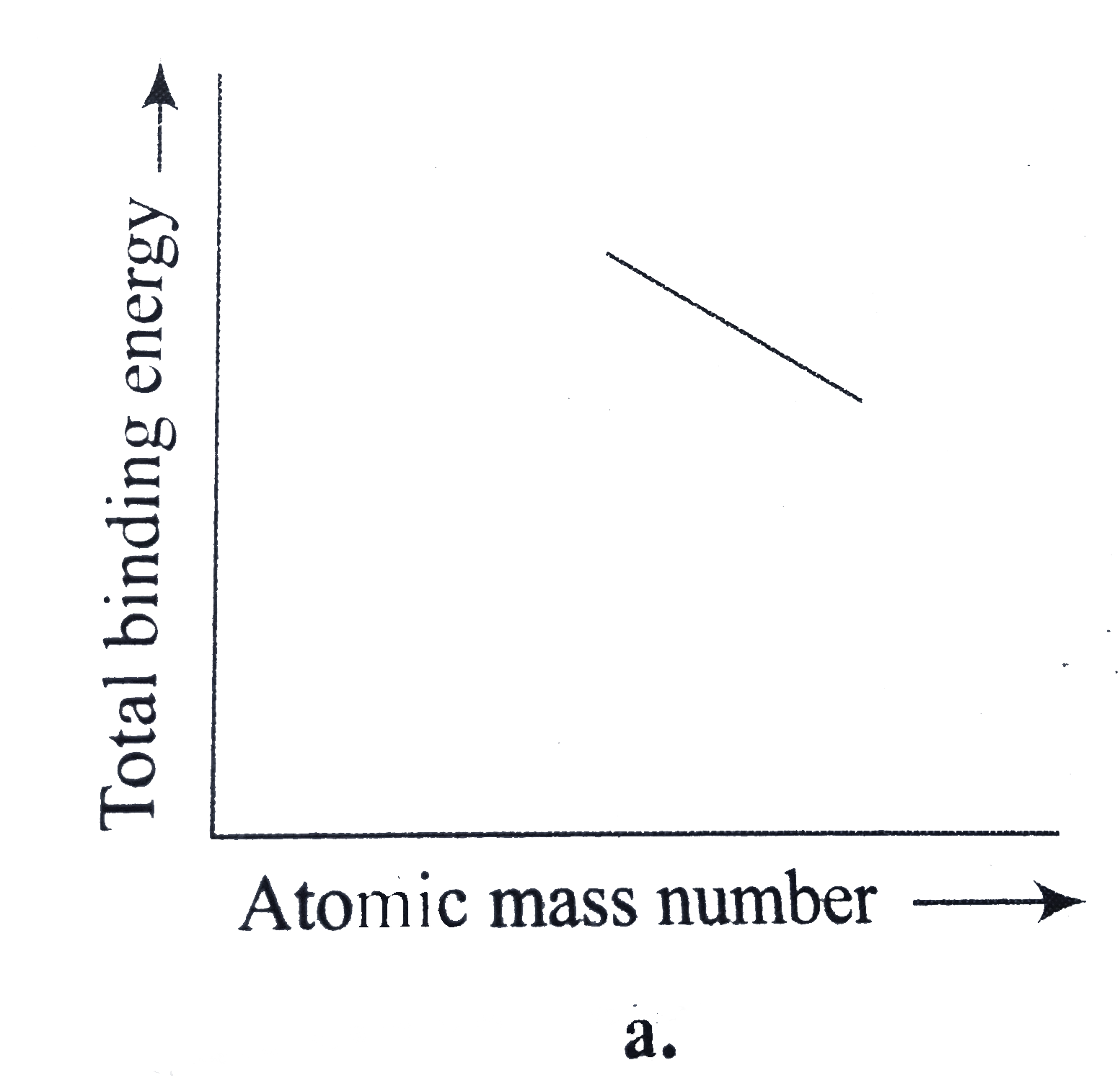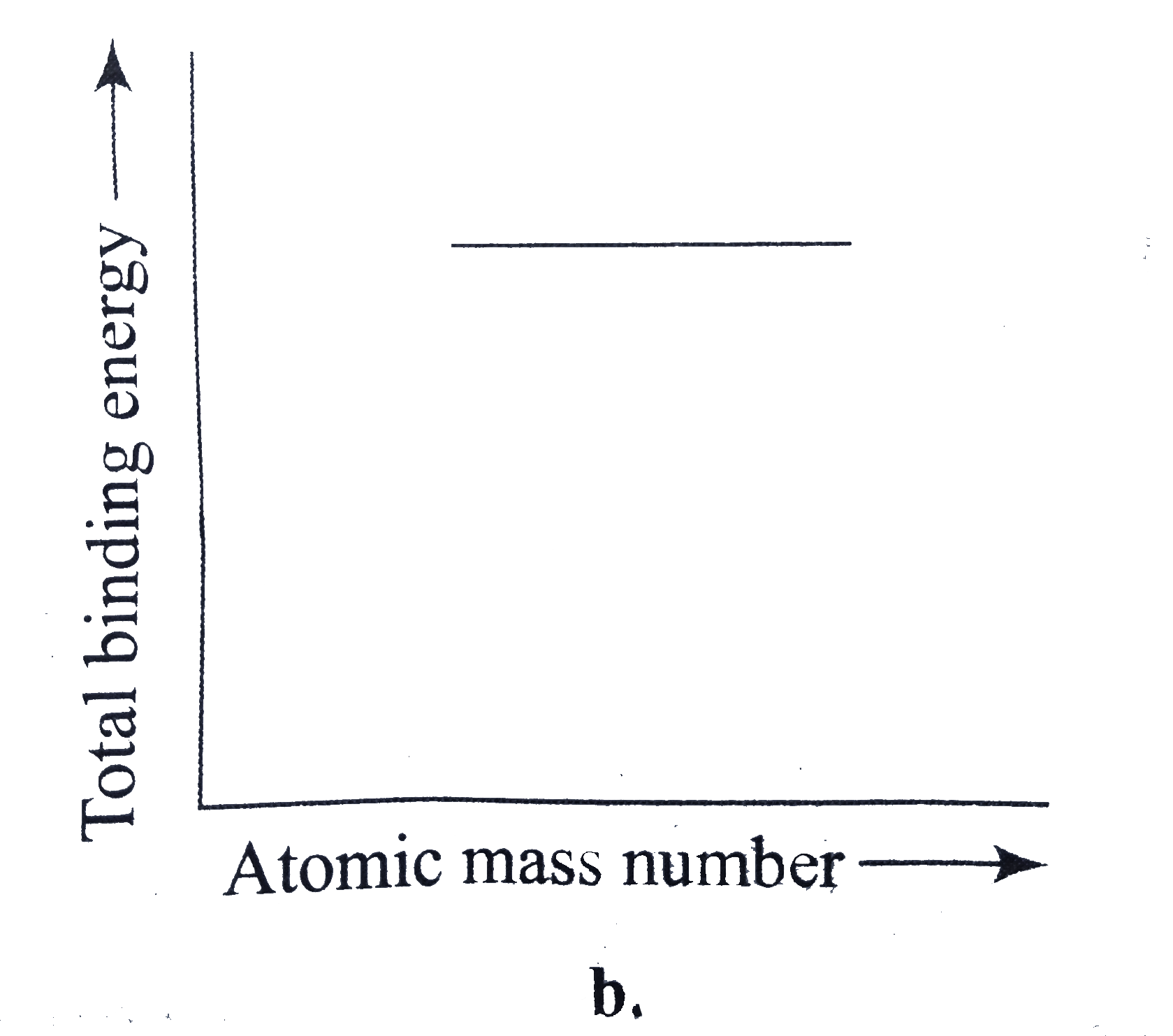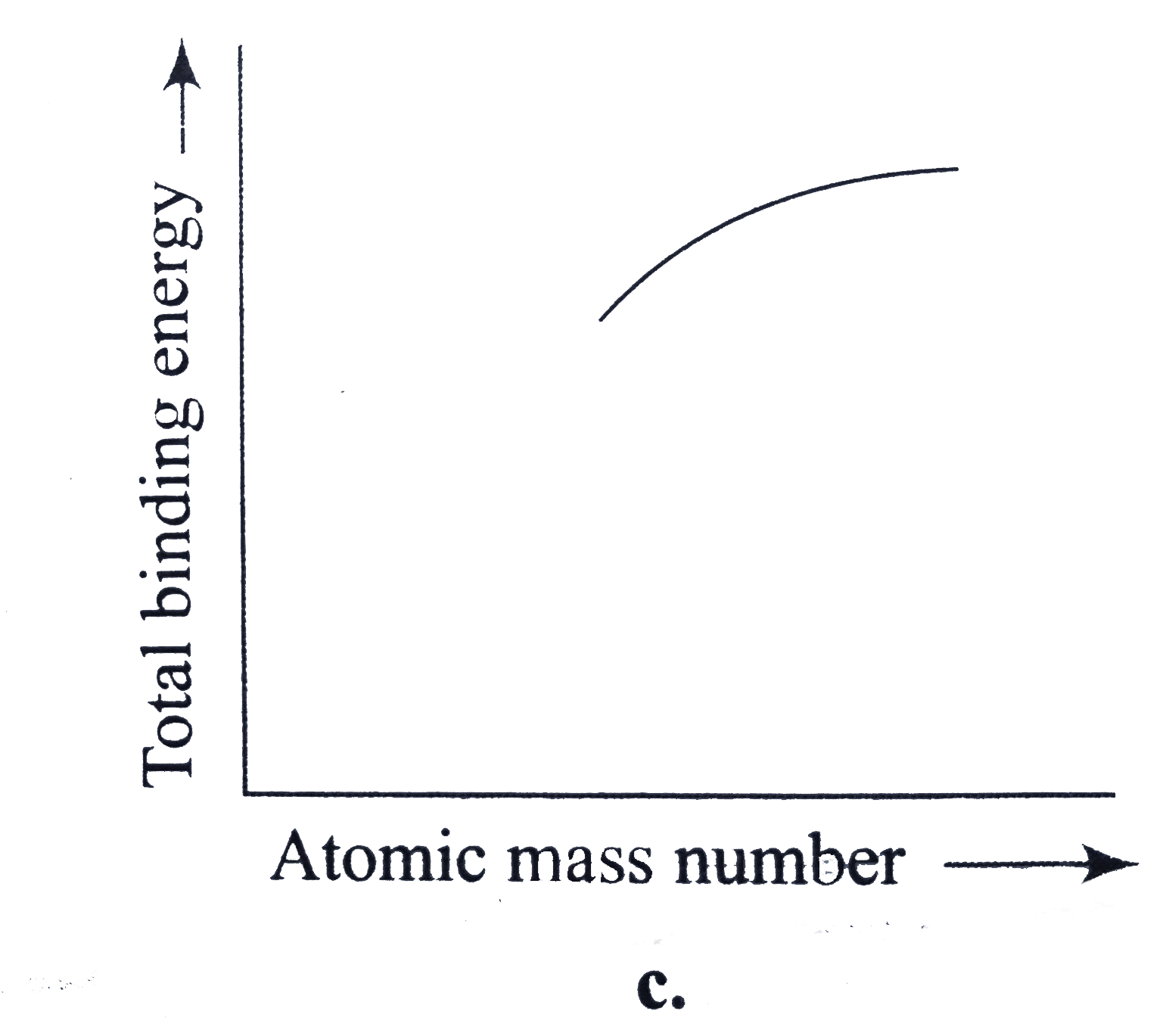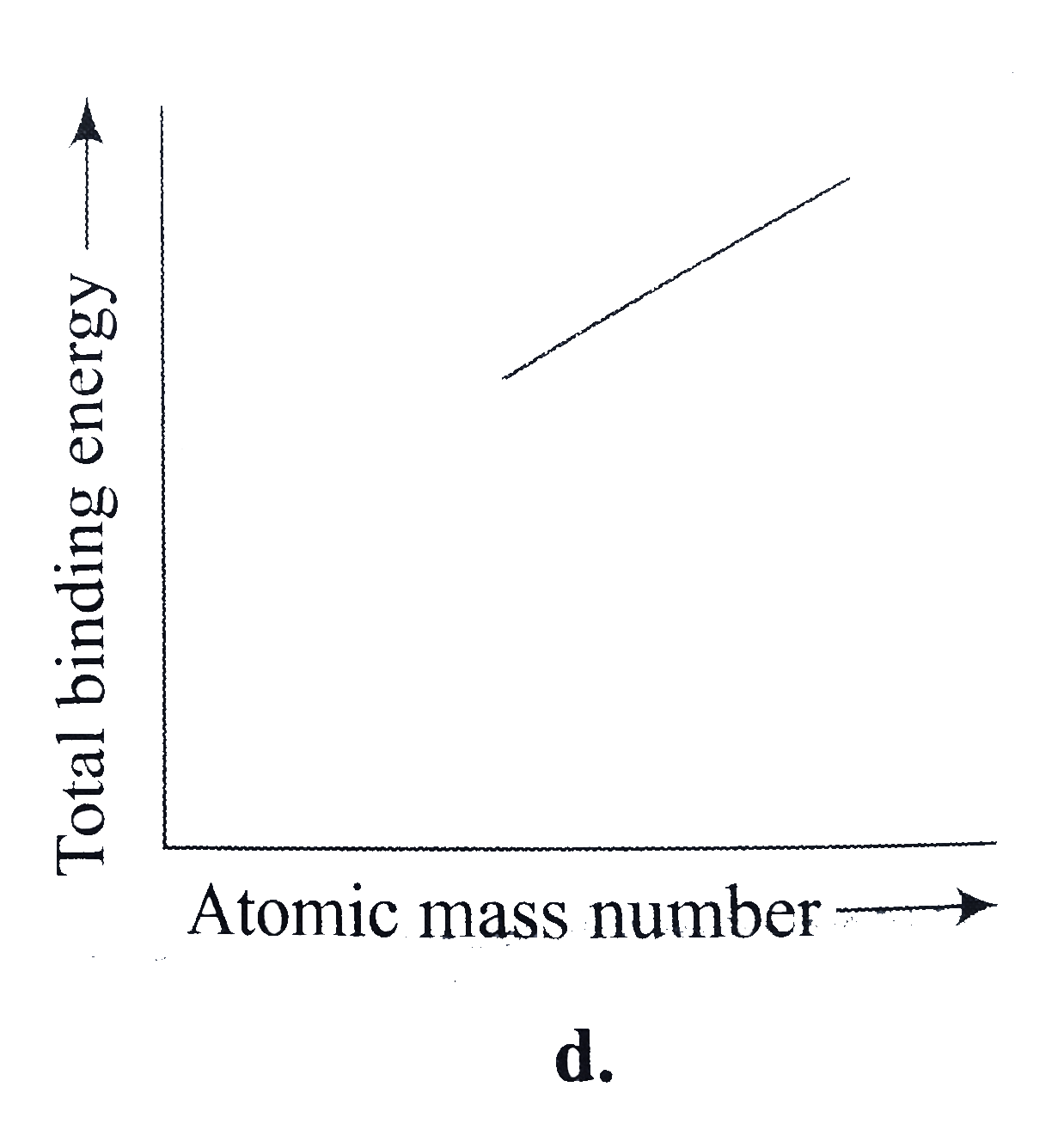The compound unstabel nucleus .23692U often decays in accordance with the following reaction
.23692U→.14054Xe+.9438Sr + other particles
During the reaction, the uranium nucleus ''fissions'' (splits) into the two smaller nuceli have higher nuclear binding energy per nucleon (although the lighter nuclei have lower total nuclear binding energies, because they contain fewer nucleons).
Inside a nucleus, the nucleons (protonsa and neutrons)attract each other with a ''strong nuclear'' force. All neutrons exert approxiamtely the same strong nuclear force on each other. This force holds the nuclear are very close together at intranuclear distances.
Which of the following graphs might represent the relationship between atomic number (i.e., ''atomic weight'') and the total binding energy of the nucleus, for nuclei heavier than .9438Sr ?




The correct Answer is:c
To solve the problem, we need to analyze the relationship between atomic number (or atomic weight) and the total binding energy of the nucleus, particularly for nuclei heavier than Strontium (Sr).
1. Understanding the Reaction:
The decay reaction given is:
23692U→14054Xe+9438Sr+other particles
Here, uranium (U) fissions into xenon (Xe) and strontium (Sr), along with other particles.
2. Binding Energy Concepts:
- Total Binding Energy: This is the energy required to disassemble a nucleus into its individual nucleons. It is proportional to the number of nucleons in the nucleus.
- Binding Energy per Nucleon: This is the total binding energy divided by the number of nucleons. It indicates how tightly the nucleons are bound within the nucleus.
3. Behavior of Binding Energy:
- For heavier nuclei (like uranium), the total binding energy is relatively high, but the binding energy per nucleon tends to decrease as the nucleus gets heavier.
- For lighter nuclei (like strontium and xenon), they have a higher binding energy per nucleon but a lower total binding energy due to having fewer nucleons.
4. Analyzing the Graph:
- We need to find a graph that shows the relationship between atomic number (or atomic weight) and total binding energy for nuclei heavier than strontium.
- As we move to heavier elements, the total binding energy should increase because the total number of nucleons is increasing, even if the binding energy per nucleon decreases.
5. Selecting the Correct Graph:
- The correct graph should show an increasing trend for total binding energy as the atomic number increases.
- Among the options provided, we look for a graph where the total binding energy rises with increasing atomic number.
Conclusion:
The correct graph that represents the relationship between atomic number and total binding energy for nuclei heavier than 9438Sr is the one that shows an increasing trend in total binding energy with increasing atomic number.
The decay reaction given is:
23692U→14054Xe+9438Sr+other particles
Here, uranium (U) fissions into xenon (Xe) and strontium (Sr), along with other particles.
- Total Binding Energy: This is the energy required to disassemble a nucleus into its individual nucleons. It is proportional to the number of nucleons in the nucleus.
- Binding Energy per Nucleon: This is the total binding energy divided by the number of nucleons. It indicates how tightly the nucleons are bound within the nucleus.
- For heavier nuclei (like uranium), the total binding energy is relatively high, but the binding energy per nucleon tends to decrease as the nucleus gets heavier.
- For lighter nuclei (like strontium and xenon), they have a higher binding energy per nucleon but a lower total binding energy due to having fewer nucleons.
- We need to find a graph that shows the relationship between atomic number (or atomic weight) and total binding energy for nuclei heavier than strontium.
- As we move to heavier elements, the total binding energy should increase because the total number of nucleons is increasing, even if the binding energy per nucleon decreases.
- The correct graph should show an increasing trend for total binding energy as the atomic number increases.
- Among the options provided, we look for a graph where the total binding energy rises with increasing atomic number.
The correct graph that represents the relationship between atomic number and total binding energy for nuclei heavier than 9438Sr is the one that shows an increasing trend in total binding energy with increasing atomic number.
Topper's Solved these Questions
- NUCLEAR PHYSICSBOOK - CENGAGE PHYSICS ENGLISHCHAPTER - NUCLEAR PHYSICSEXERCISE - Integer
6 Videos
- NUCLEAR PHYSICSBOOK - CENGAGE PHYSICS ENGLISHCHAPTER - NUCLEAR PHYSICSEXERCISE - Fill In The Blanks
5 Videos
- NUCLEAR PHYSICSBOOK - CENGAGE PHYSICS ENGLISHCHAPTER - NUCLEAR PHYSICSEXERCISE - Single Correct Option
182 Videos
- MISCELLANEOUS VOLUME 5BOOK - CENGAGE PHYSICS ENGLISHCHAPTER - MISCELLANEOUS VOLUME 5EXERCISE - Integer
12 Videos
- PHOTOELECTRIC EFFECTBOOK - CENGAGE PHYSICS ENGLISHCHAPTER - PHOTOELECTRIC EFFECTEXERCISE - Integer Type
4 Videos
Similar Questions
The compound unstabel nucleus .23692U often decays in accordance with the following reaction
_(92)236U→.14054Xe+9438Sr+ other particles
During the reaction, the uranium nucleus ''fissions'' (splits) into the two smaller nuceli have higher nuclear binding energy per nucleon (although the lighter nuclei have lower total nuclear binding energies, because they contain fewer nucleons).
Inside a nucleus, the nucleons (protonsa and neutrons)attract each other with a ''strong nuclear'' force. All neutrons exert approxiamtely the same strong nuclear force on each other. This force holds the nuclear are very close together at intranuclear distances.
In the nuclear reaction presented above, the ''other particles'' might be .
View SolutionThe compound unstabel nucleus .23692U often decays in accordance with the following reaction
.23692U→.14054Xe+.9438Sr + other particles
During the reaction, the uranium nucleus ''fissions'' (splits) into the two smaller nuceli have higher nuclear binding energy per nucleon (although the lighter nuclei have lower total nuclear binding energies, because they contain fewer nucleons).
Inside a nucleus, the nucleons (protons and neutrons)attract each other with a ''strong nuclear'' force. All neutrons exert approxiamtely the same strong nuclear force on each other. This force holds the nuclear are very close together at intranuclear distances.
Why is a .42He nucleus more stable than a .43Li nucleus?
View SolutionThe compound unstabel nucleus .23692U often decays in accordance with the following reaction
.23692U→.14054Xe+.9438Sr + other particles
During the reaction, the uranium nucleus ''fissions'' (splits) into the two smaller nuceli have higher nuclear binding energy per nucleon (although the lighter nuclei have lower total nuclear binding energies, because they contain fewer nucleons).
Inside a nucleus, the nucleons (protonsa and neutrons)attract each other with a ''strong nuclear'' force. All neutrons exert approxiamtely the same strong nuclear force on each other. This force holds the nuclear are very close together at intranuclear distances.
A proton and a neutron are both shot at 100ms−1 toward a .126C nucleus. Which particle, if either, is more likely to be absorbed by the nucleus?
View SolutionThe value of binding energy per nucleon is
View SolutionThe binding energy per nucleon is maximum in the case of.
View SolutionThe binding energy per nucleon is maximum in the case of.
View SolutionAverage binding energy per nucleon over a wide range is
View SolutionAs the mass number A increases, the binding energy per nucleon in a nucleus.
View SolutionWhen two nuclei (with A=8) join to form a heavier nucleus , the binding energy (B.E) per nucleon of the heavier nuclei is
View SolutionWhat is the significance of binding energy per nucleon of a nucleus of a radioactive element ?
View Solution
